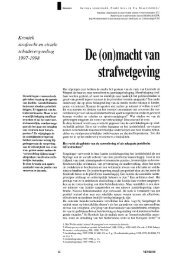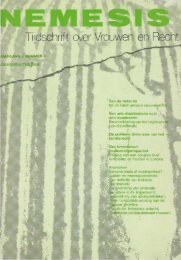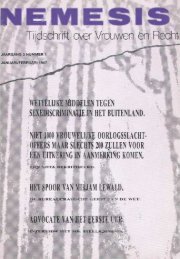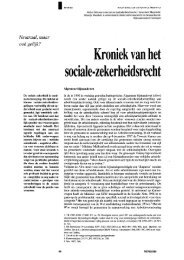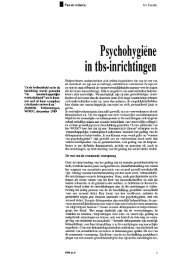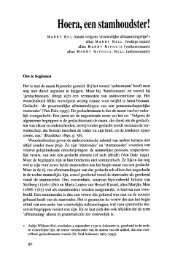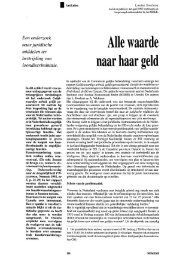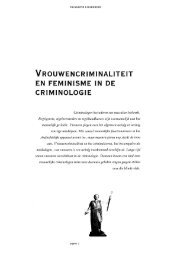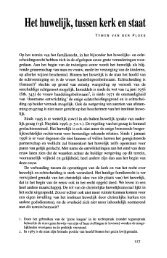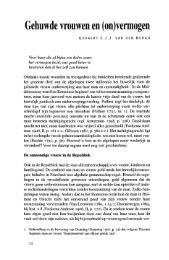(2001) nummer 1 januari/februari - Nemesis
(2001) nummer 1 januari/februari - Nemesis
(2001) nummer 1 januari/februari - Nemesis
You also want an ePaper? Increase the reach of your titles
YUMPU automatically turns print PDFs into web optimized ePapers that Google loves.
come the child's legal father if he wants to, but the<br />
mother withholds consent. If in such a case the new requirement<br />
leads the court to conclude that the donor<br />
could eventually have a tie with the child, the non-biological<br />
mother cannot adopt the child, nor can the<br />
donor become the child's legal father. As a result the<br />
child ends up in alegal no man's land'. 4<br />
Van Vliet's criticism is an important one because, if<br />
the new requirement is interpreted in this way, it clearly<br />
discriminates against AID children born into a marriage<br />
between two women. In a heterosexual marriage<br />
a non-biological parent, the husband of the mother, is<br />
granted legal parenthood through parentage law. Under<br />
the current proposals, however, not only is the nonbiological<br />
female spouse denied parenthood, but the<br />
court may deny her petition to adopt the child if the<br />
court determines that, sometime in the future, the child<br />
may have something to expect from the sperm donor,<br />
although the sperm donor is not even considered the legal<br />
parent of the child. It seems that the government is<br />
willing to ignore a biological parent, the sperm donor,<br />
only if there is a man, the husband, in the child's family.<br />
By not allowing automatic parentage to a female<br />
spouse, forcing her to go through an adoption, in addition<br />
to interjecting the sperm donor into the adoption<br />
proceeding, one could criticize the government for going<br />
to extreme lengths to prevent legal recognition of a<br />
family that does not model the patriarchal ideal of a<br />
family unit - a unit that must be comprised of one man<br />
and one woman. In doing so, the government not only<br />
ignores the social reality of children who have two<br />
same-gender parents, but more importantly, denies<br />
these children important legal protections of their relationship<br />
with their second parent.<br />
Van Vliet's criticism of the government's preferential<br />
treatment of heterosexual married couples who have<br />
children using AID is well taken, particularly when<br />
viewed in the light of legal developments in the United<br />
States. The United States has had a substantial number<br />
of AID births 5 and in several cases, sperm donors have<br />
asserted parental rights to the child born through an<br />
AID birth. With the exception of only one case, in<br />
every reported U.S. case involving an AID child who<br />
was not born into a heterosexual marriage, the known<br />
sperm donor father has been successful in obtaining a<br />
court declaration of legal parenthood. In other words,<br />
these cases demonstrate how f ar the United States'<br />
courts are willing to go in order to interpose a male into<br />
a child's life, regardless of the social reality of that<br />
child's life.<br />
This article reviews these various cases, thereby allowing<br />
the reader to see what might happen in the<br />
Netherlands if the Dutch parliament does not amend<br />
the parentage law to grant parental status to the female<br />
spouse of the mother, particularly if the sperm donor is<br />
considered an interested party when that spouse attempts<br />
to adopt the child. The article begins with an explanation<br />
of parentage law in the United States, in-<br />
4. ld.<br />
5. For example, in 1987 it was reported that 178.000 women underwent<br />
AID, resulting in 30.000 children born through the AID procedure.<br />
Elizabeth L. Gibson, 'Artificial Insemination by Donor: Infor-<br />
TAKING THE SIDE EXIT IN THE UNITED STATES NANCY G. MAXWELL<br />
cluding a discussion of the constitutional ramifications<br />
of parental rights. Next the article examines the U.S.<br />
court decisions involving known sperm donors asserting<br />
parental rights. The purpose of case law examination<br />
is three-fold. First of all, under the common law<br />
system, the courts have the authority to make law in the<br />
absence of statutory provisions that deal with a particular<br />
issue before the court. Unlike the civil law system,<br />
in which case decisions are mere jurisprudence, in the<br />
common law system the court decisions are the law<br />
and the appellate court decisions must be followed by<br />
the inferior courts. Consequently, in those situations in<br />
which there are no applicable AID statutes, the court<br />
decisions become the sole law on the subject of<br />
whether known sperm donors have parental rights.<br />
Second, even when the legislature has enacted statutes<br />
that address the parental rights of sperm donors, the<br />
courts have the authority to interpret those statutes and<br />
these interpretations become binding law until the legislature<br />
amends the statute. Finally, the courts in the<br />
United States have the authority to strike down statutes<br />
as violations of federal or state constitutional provisions,<br />
resulting in the statutes becoming unenforceable.<br />
Interestingly, all three of these possibilities occur<br />
within the small number of U.S. cases involving the issue<br />
of whether known sperm donors can obtain<br />
parental rights. Consequently, any discussion of the<br />
status of the law on the parental rights of known sperm<br />
donors must involve an examination of case law.<br />
In several cases, sperm donors have<br />
asserted parental rights to the child born<br />
through an AID birth<br />
After the discussion of the cases, the article analyzes<br />
the cases, setting out the lengths to which the U.S.<br />
courts have gone to support a sperm donor' s action to<br />
obtain legal parentage. In addition, the article points<br />
out that, by recognizing the sperm donor as a parent,<br />
the sperm donor can prevent the child's non-biological<br />
social parent from adopting the child. In fact, establishing<br />
a known sperm donor as a legal parent may prevent<br />
the social parent from obtaining any legal standing,<br />
whatsoever, to protect her relationship with the<br />
child. The article concludes with a warning that, without<br />
automatic parenthood for female spouses of<br />
women who have children using AID, the Netherlands<br />
will be joining the United States in sending a particular<br />
group of children to a side exit, where they must exist<br />
without legal protections for their relationship with<br />
their second parent and without legal recognition of the<br />
reality of their daily lives.<br />
Parentage Law in the United States<br />
Although each state in the United States has the authority<br />
to determine the laws concerning a child's<br />
mation, Communication and Regulation', 30/ Fam. L. 1, 1, 1991-<br />
92 (citing U.S. Congress, Office of Technology Assessment, Artificial<br />
Insemination Practice in the United States: Summary ofa 1987<br />
SurveyS, 1988.)<br />
NEMESIS <strong>2001</strong> nr. 1 15



